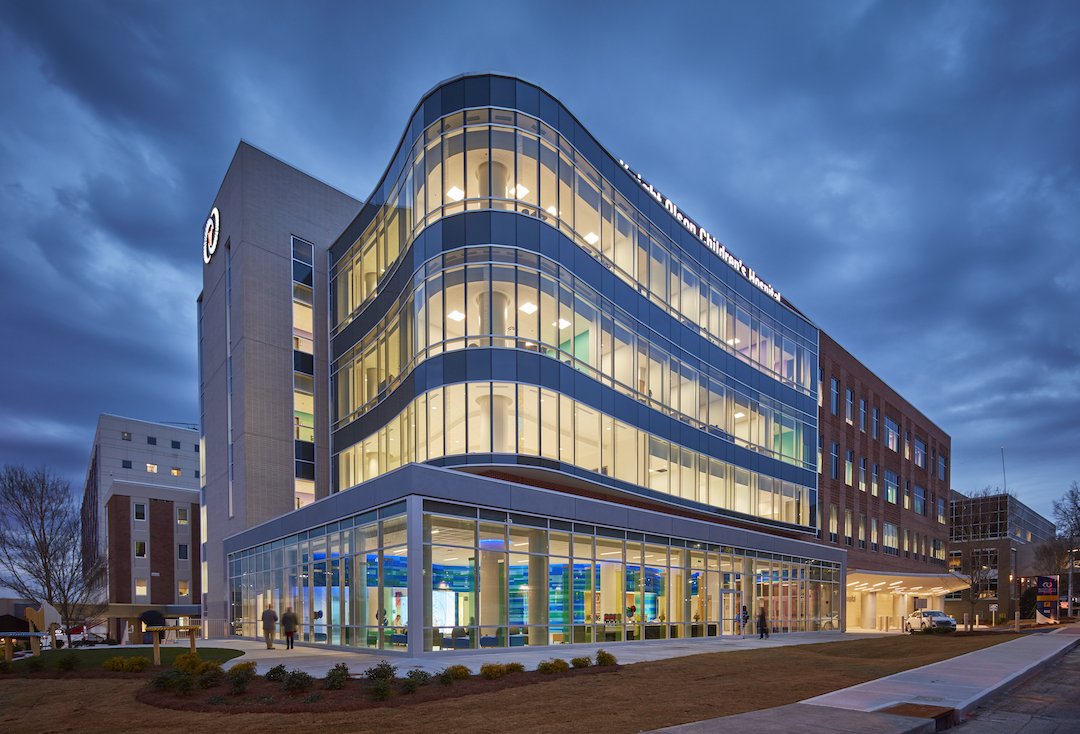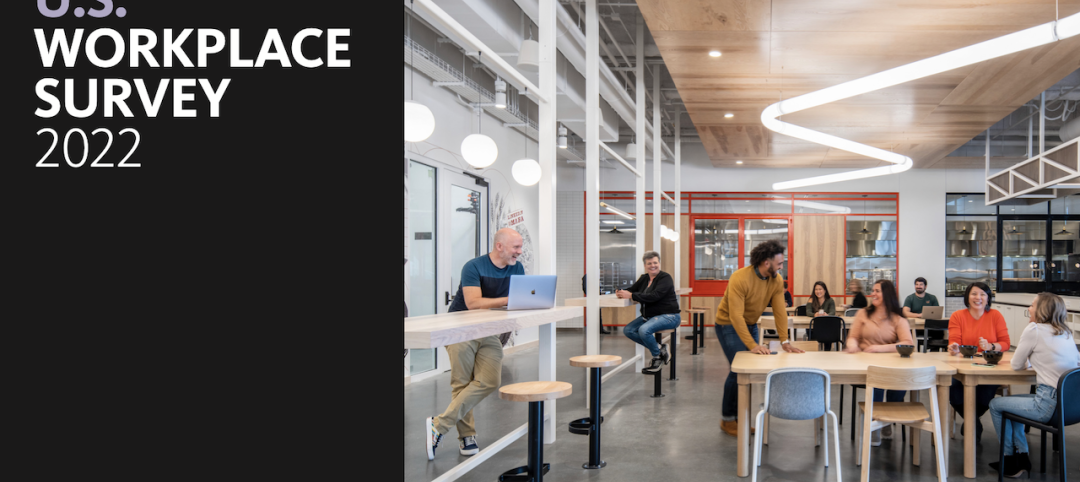Upgrades to medical equipment and systems and improvements to building systems are the current focus in the healthcare market.
Healthcare consolidation contributes to this trend. After larger health systems acquire smaller, rural facilities, there’s typically a push to renovate them and upgrade technology, says Robin Savage, President/COO, Robins & Morton. “A lot of this work is centered on diagnostic and imaging and service areas like women’s services,” says Savage.
The next big advancement: the so-called “smart hospital.” With multiple systems able to communicate with each other, such a building perform functions like another medical practitioner.
At the $1.6 billion Mackenzie Vaughan Hospital, now under construction in Toronto, building systems and medical technology will be linked. When a patient’s monitor detects a heart attack, it will send a silent alert to critical care response team members equipped with wearable location services badges. The badges will automatically override elevator controls, giving team members express service to the patient’s floor.
ALSO SEE: Top 150 Healthcare Architecture Firms
ALSO SEE: Top 90 Healthcare Engineering Firms
ALSO SEE: Top 100 Healthcare Construction Firms
Engineering giant WSP is examining ways to deploy Amazon Echo to aid HIPAA compliance and patient safety, says WSP’s Gary Hamilton, Senior Vice President and Eastern Healthcare Lead. Alerts could be sent to surgical recovery nurses every four hours to ensure that patients receive pain medication on time.
Smart hospitals will also boost energy efficiency. Artificial intelligence would analyze data from building management systems and scheduling software to determine how best to use space. Knowing that a patient was just discharged, smart building technology could turn down the HVAC in the empty room and punch it back up when the room is scheduled to be reoccupied.
Using fiber optic systems throughout the building, MEP systems can be integrated with low-voltage systems such as AV and alarm systems. Once linked, these systems can enable smart hospital features. “In five years, the occupant-aware building is going to be commonplace in healthcare,” says Hamilton.
BIM and virtual reality are being used to analyze how healthcare medical professionals use space. “As we design key clinical spaces, we are mapping travel distances,” says Kate Renner, AIA, LEED AP BD+C, Design Researcher and Architect, HKS Inc. The data populates detailed behavior maps, which inform the creation of digital renderings that can be experienced in VR.
HKS also creates full-scale cardboard mockups of key spaces such as inpatient rooms and surgical suites that provide valuable feedback from medical personnel on the positioning of equipment, cabinetry, and sinks.
Coping with natural disasters also figures into the early stages of programming and design. A sudden influx of patients from a hurricane, tornado, or earthquake could be accommodated if emergency rooms were equipped with double medical gas outlets in headwalls so that trauma victims could be doubled up in each room. Post-anesthesia care units outfitted with extra medical gas and headwall capacity could also function as emergency care units following a disaster, says Renner.
Structural dampeners and reinforced stabilizers for overhead MEP systems are being required in earthquake-prone areas. After Mercy Hospital, Joplin, Mo., was destroyed by a tornado in 2011, collapsed MEP assemblies were found to be the major source of damage, says Renner. To make the replacement structure more resilient, the design also included reinforced stabilizers for the MEP systems, laminated safety glass, reinforced stairwells, battery-powered lights, and wall hooks that can be used to ease patients down stairs with sleds and ropes.
Owners of critical facilities have increased their supply of water storage and generator fuel, Hamilton says. The Veteran’s Administration now requires a two-week supply of water, not the previous one-week standard.
Offsite construction ON THE UPSWING in healthcare sector
Prefab construction of mechanical systems continues to grow. “At least one headwall manufacturer is now including ductwork and insulation,” says Hamilton. “At most trade shows, we’re seeing four or five prefab bathroom manufacturers.”
Prefab exterior wall systems are an increasingly compelling option, says Tim Johnson, Vice President/Division Manager, Brasfield & Gorrie. Evaluating prefab options is a task owners now count on their project teams to assess.
Lean construction is also in demand. “At least three out of four RFPs that we see address Lean management and Lean construction,” Savage says. Contractors must be involved earlier than ever to provide cost and constructability analysis. “Architects and GCs are now being selected at about the same time,” says Johnson.
“During pre-construction, owners require you to commit expensive and knowledgeable resources at the beginning—as much as 12 months before breaking ground,” says Savage. The extra effort does make for an improved architect-contractor relationship, says Hannah Wickham, Vice President, Business Development, Brasfield & Gorrie.
MORE FROM BD+C'S 2019 GIANTS 300 REPORT
Related Stories
Adaptive Reuse | Mar 5, 2023
Pittsburgh offers funds for office-to-residential conversions
The City of Pittsburgh’s redevelopment agency is accepting applications for funding from developers on projects to convert office buildings into affordable housing. The city’s goals are to improve downtown vitality, make better use of underutilized and vacant commercial office space, and alleviate a housing shortage.
Student Housing | Mar 5, 2023
Calif. governor Gavin Newsom seeks to reform environmental law used to block student housing
California Gov. Gavin Newsom wants to reform a landmark state environmental law that he says was weaponized by wealthy homeowners to block badly needed housing for students at the University of California, Berkeley.
Green Renovation | Mar 5, 2023
Dept. of Energy offers $22 million for energy efficiency and building electrification upgrades
The Buildings Upgrade Prize (Buildings UP) sponsored by the U.S. Department of Energy is offering more than $22 million in cash prizes and technical assistance to teams across America. Prize recipients will be selected based on their ideas to accelerate widespread, equitable energy efficiency and building electrification upgrades.
Windows and Doors | Mar 5, 2023
2022 North American Fenestration Standard released
The 2022 edition of AAMA/WDMA/CSA 101/I.S.2/A440, “North American Fenestration Standard/Specification for windows, doors, and skylights” (NAFS) has been published. The updated 2022 standard replaces the 2017 edition, part of a continued evolution of the standard to improve harmonization across North America, according to a news release.
AEC Innovators | Mar 3, 2023
Meet BD+C's 2023 AEC Innovators
More than ever, AEC firms and their suppliers are wedding innovation with corporate responsibility. How they are addressing climate change usually gets the headlines. But as the following articles in our AEC Innovators package chronicle, companies are attempting to make an impact as well on the integrity of their supply chains, the reduction of construction waste, and answering calls for more affordable housing and homeless shelters. As often as not, these companies are partnering with municipalities and nonprofit interest groups to help guide their production.
Modular Building | Mar 3, 2023
Pallet Shelter is fighting homelessness, one person and modular pod at a time
Everett, Wash.-based Pallet Inc. helped the City of Burlington, Vt., turn a municipal parking lot into an emergency shelter community, complete with 30 modular “sleeping cabins” for the homeless.
Codes | Mar 2, 2023
Biden Administration’s proposed building materials rules increase domestic requirements
The Biden Administration’s proposal on building materials rules used on federal construction and federally funded state and local buildings would significantly boost the made-in-America mandate. In the past, products could qualify as domestically made if at least 55% of the value of their components were from the U.S.
Industry Research | Mar 2, 2023
Watch: Findings from Gensler's latest workplace survey of 2,000 office workers
Gensler's Janet Pogue McLaurin discusses the findings in the firm's 2022 Workplace Survey, based on responses from more than 2,000 workers in 10 industry sectors.
AEC Innovators | Mar 2, 2023
Turner Construction extends its ESG commitment to thwarting forced labor in its supply chain
Turner Construction joins a growing AEC industry movement, inspired by the Design for Freedom initiative, to eliminate forced labor and child labor from the production and distribution of building products.
Multifamily Housing | Mar 1, 2023
Multifamily construction startup Cassette takes a different approach to modular building
Prefabricated modular design and construction have made notable inroads into such sectors as industrial, residential, hospitality and, more recently, office and healthcare. But Dafna Kaplan thinks that what’s held back the modular building industry from even greater market penetration has been suppliers’ insistence that they do everything: design, manufacture, logistics, land prep, assembly, even onsite construction. Kaplan is CEO and Founder of Cassette, a Los Angeles-based modular building startup.

















